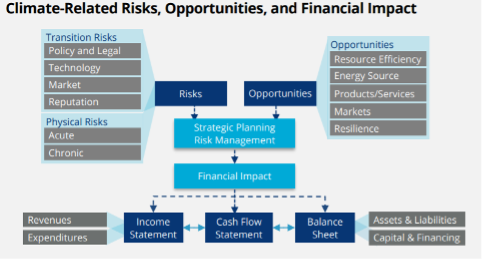TCFD rules pervade the financial and ESG reporting landscape

Using a sustainability platform like CarbonView becomes more important as the requirements for disclosure become more wide reaching. In 2015, at the inauguration of the Paris Agreement, the Task Force on Climate-Related Financial Disclosure (TCFD) was created by the Financial Stability Board (FSB) to develop recommendations on the types of information that companies should disclose to support investors, lenders, and insurance underwriters in appropriately assessing and pricing risks related to climate change.
At the 2021 G7 meeting in Cornwall, leaders agreed to introduce a mandatory TCFD reporting requirements in coming years. The UK is the first, commencing on 6 April. The other six nations, including Canada, the US, France, Germany, Italy and Japan are expected to outline their proposals shortly.
Also committed to introducing a TCFD mandate are Switzerland, which has set a 2024 introduction date, and New Zealand, which is aiming to introduce its rules in 2025. No word on Australia yet, but with the change from 9 years of the LNP government in 2022 there may be a push to align with our global partners.
Separately, the US Security and Exchange Commission (SEC) last month unveiled proposals to mandate bigger businesses to disclose their emissions in a unified way, including indirect (Scope 3) emissions. If the proposal passes, information will need to be included in publicly available annual reports as early as next year.
Approximately 1300 companies are subject to the new UK legislation and include listed companies, banks, insurers with more than 500 employees and non-listed companies with more than 500 employees and more than £500m in annual sales (applies to total consolidated group revenues). The TCFD mandatory criteria will be extended to smaller companies in 2023.
The required disclosures are:
• A description of the organisation’s governance-related arrangements to measuring and managing climate-related risks and opportunities.
• A description of the processes in place for measuring and managing climate-related risks and opportunities.
• A description of how the above is integrated into an organisation’s overall risk management process.
• A description of the key climate-related risks and opportunities arising from the organisation’s operations.
• A description of the actual and potential impacts of these key climate-related risks and opportunities on a company’s strategy and business model.
• Scenario analysis: An assessment of the resilience of the organisation’s business model and strategy in a range of different warming scenarios.
• A list of the organisation’s targets relating to climate impact reduction, climate risks management and maximising climate opportunities.
• Details of performance against the above targets to date, including a list of the KPIs used to assess progress.
The TCFD has four pillars, namely, governance, strategy, risk management and metrics & targets. The governance and risk management pillars are dedicated to ensuring organisations maintain appropriate internal policies and processes to meet disclosure requirements. Metrics & targets is the quantification pillar which is important for assessing how an organisation is progressing towards its targets.
Strategy is the pillar where organisations drill down to understand the risks, opportunities and threats of the impacts of climate change that will affect their stakeholders. However, the financial impacts of climate-related issues on organizations are not always clear or direct. Key reasons for this are likely because of:
• Limited knowledge of climate-related issues within organizations.
• The tendency to focus mainly on near-term risks without paying adequate attention to risks that may arise in the longer term.
• The difficulty in quantifying the financial effects of climate-related issues.
Recognizing these difficulties, the TCFD has established a structure to identify areas of risk, opportunity and threat. The illustration below from the Final Report of the TCFD diagrammatically represents this structure.

TCFD divides risks into two categories i.e. transitional risks and physical risks. Transitional risks are inherent in the required altered strategies, policies or investments needed for industry to reduce its reliance on carbon and impact on the climate. Physical risks are categorised as acute (event-driven) and chronic risks (those due to longer-term shifts in climate patterns).
An organisation describes these risks (and opportunities) over the short, medium and long term, and also how it impacts on an organisation’s strategy and financial planning. Additionally, it must describe resilience of the business’s strategy – considering different climate-related scenarios, for example a 2C or 1.5C scenario.
In terms of specific detail, the TCFD recommends companies consider the lifecycle of assets and infrastructure and how climate-related issues manifest themselves over the medium and longer term. Also, it calls on companies to consider how it impacts on products and services; supply and value chain; adaptation and mitigation; investment in research and development; and operations.
In ensuing blogs we will explore the processes of the Strategy pillar in more detail. In particular, we will look at the structure of scenario analysis.
On the ESG front, the five major networks i.e. CDP, CDSB, GRI, IIRC and SASB have co-published a shared vision of the elements necessary for more comprehensive corporate reporting and a joint statement of intent to drive towards this goal – by working together and by each committing to engage with key actors, including IOSCO and the IFRS, the European Commission, and the World Economic Forum’s International Business Council.
A significant initiative towards unity between the maze of organisations is the establishment of the IFRS Foundation to develop a single set of high-quality, understandable, enforceable and globally accepted accounting and sustainability disclosure standards—IFRS Standards—and to promote and facilitate adoption of these standards.
The two Standards are being developed by IFRS’ two standard-setting boards, the International Accounting Standards Board (IASB) and the newly created International Sustainability Standards Board (ISSB).
The IASB sets IFRS Accounting Standards which set out how a company prepares its financial statements. The ISSB sets IFRS Sustainability Disclosure Standards which sets out how a company discloses information about sustainability-related factors that may help or hinder a company in creating value. The recommended processes of the TCFD underpin these standards.
It is important to also mention the Science Based Targets initiative (SBTi), which is considered the leading authority in developing guidance and assessing targets for organisations in line with the Paris Agreement. SBTs define how much and how quickly individual companies need to reduce their emissions to keep global warming to less than a 1.5°C increase above pre-industrial levels.
Whilst TCFD is focussed on financial disclosure and SBTi on target-setting, there is a clear synergy between both functions. SBTi enables companies to meet the requirements of the Metrics and Targets area of the TCFD recommendations.
Based on both TCFD recommendations and the SBTi validation criteria, companies are expected to disclose the following information alongside their targets:
• Type of target – whether the target is absolute or intensity-based.
• Time frames
• Key performance indicators used to assess progress against targets
• Approaches for calculating targets
Further, the case for using CarbonView as a centralised platform to manage these disclosures is that TCFD recommends disclosing Scope 1, 2 and if appropriate, 3 greenhouse gas (GHG) emissions and associated risks. CarbonView allows companies to calculate their emissions in line with the GHG Protocol and provides industry-specific GHG efficiency ratios.
For setting an SBTi target, a company is required to calculate Scope 1 and 2 emissions and screen Scope 3 emissions in order to determine whether a target is going to be needed. If scope 3 emissions comprise more than 40% of the total footprint, the SBT should include scope 3 emissions. SBTi specifies the adoption of the minimum emissions boundaries of the GHG Protocol Corporate Value Chain (Scope 3) Accounting & Reporting Standard.
